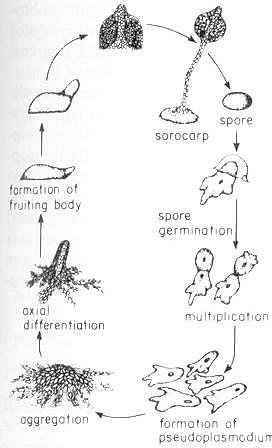 |
The slime moulds have a life cycle which alternates between a unicellular feeding stage and a multicellular reproductive stage as described in the followings:
- They begin their life from spore germination and multiplication.
- The basic units of slime moulds are haploid amoebae, usually prowling around on the forest floor consuming bacteria.
- Once the supply of food is exhausted, individual amoebae begin to move together. They form streams of cells (see lower Figure) called pseudoplasmodium (see upper Figure) moving slowly at about one millimeter/hour. It is now known that the process is initiated with the cAMP1 signaling molecules released by the starving amoebae.
- Eventually the streams come together and form an aggregation which is at the spot with high concentration of cAMP. The mass can number a hundred thousand cells and might reach a size of a few millimeters.
- Then they stick together by secreting adhesion molecules and creating a slime sheath (cap) which covers all the cells in the mass. The polarity defined by the anterior (front), posterior (back) ends is established by oxygen gradient. The responsible gene for adhesion can be identified by blocking its expression. The resulting mass becomes a loose rubble that is incapable of further development.
|

